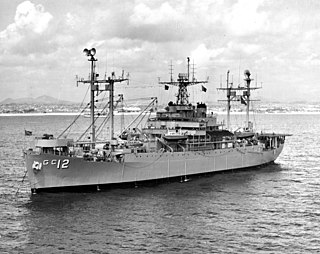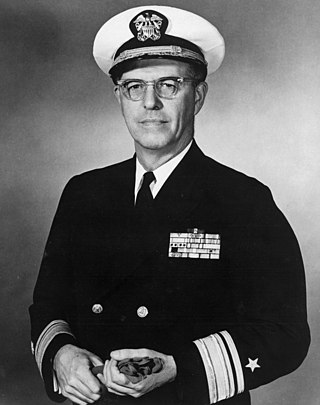
Operation Crossroads was a pair of nuclear weapon tests conducted by the United States at Bikini Atoll in mid-1946. They were the first nuclear weapon tests since Trinity on July 16, 1945, and the first detonations of nuclear devices since the atomic bombing of Nagasaki on August 9, 1945. The purpose of the tests was to investigate the effect of nuclear weapons on warships.

USS Blandy (DD-943) was a Forrest Sherman-class destroyer, named for Admiral William H. P. Blandy USN (1890–1954),

William Sterling Parsons was an American naval officer who worked as an ordnance expert on the Manhattan Project during World War II. He is best known for being the weaponeer on the Enola Gay, the aircraft which dropped an atomic bomb on Hiroshima, Japan, in 1945. To avoid the possibility of a nuclear explosion if the aircraft crashed and burned on takeoff, he decided to arm the bomb in flight. While the aircraft was en route to Hiroshima, Parsons climbed into the cramped and dark bomb bay, and inserted the powder charge and detonator. He was awarded the Silver Star for his part in the mission.

USS Blue Ridge (AGC-2) was an Appalachian-class amphibious force flagship in the United States Navy. She was named for the southeasternmost ridge of the Appalachian Mountains in Virginia and North Carolina.

Mahan-class destroyers of the United States Navy were a series of 18 destroyers of which the first 16 were laid down in 1934. The last two of the 18, Dunlap and Fanning, are sometimes considered a separate ship class. All 18 were commissioned in 1936 and 1937. Mahan was the lead ship, named for Rear Admiral Alfred Thayer Mahan, an influential historian and theorist on sea power.

The Benham class of ten destroyers was built for the United States Navy (USN). They were part of a series of USN destroyers limited to 1,500 tons standard displacement by the London Naval Treaty and built in the 1930s. The class was laid down in 1936-1937 and all were commissioned in 1939. Much of their design was based on the immediately preceding Gridley and Bagley-class destroyers. Like these classes, the Benhams were notable for including sixteen 21-inch (533 mm) torpedo tubes, the heaviest torpedo armament ever on US destroyers. They introduced a new high-pressure boiler that saved space and weight, as only three of the new boilers were required compared to four of the older designs. The class served extensively in World War II in the Atlantic, Mediterranean, and Pacific theaters, including Neutrality Patrols in the Atlantic 1940-1941. Sterett received the United States Presidential Unit Citation for the Battle of Guadalcanal and the Battle of Vella Gulf, and the Philippine Republic Presidential Unit Citation for her World War II service. Two of the class were lost during World War II, three were scrapped in 1947, while the remaining five ships were scuttled after being contaminated from the Operation Crossroads atomic bomb tests at Bikini Atoll in the Pacific.

The first USS Henderson (AP-1) was a transport in the United States Navy during World War I and World War II. In 1943, she was converted to a hospital ship and commissioned as USS Bountiful (AH-9).

USS Blue (DD-744), an Allen M. Sumner-class destroyer, was the second United States Navy ship of that name, for Lieutenant Commander John S. Blue (1902–1942).

The third USS Lamson (DD-367) was a Mahan-class destroyer of the United States Navy; named for Roswell Hawkes Lamson. She served in the Pacific during World War II. Lamson participated in the Battle of Tassafaronga, and remained undamaged until hit by a Japanese kamikaze during the recapture of the Philippines. Lamson was sunk during the Operation Crossroads atomic weapons tests at Bikini Atoll in 1946.

USS John Rodgers (DD-574) was a Fletcher-class destroyer of the United States Navy commissioned during World War II and the second ship to bear the name. She was named after three members of the Rodgers family who served in the Navy from the War of 1812 through World War I. John Rodgers served in several wartime actions in the Pacific, receiving 12 battle stars.

Frederick Lincoln "Dick" Ashworth was a United States Navy officer who served as the weaponeer on the B-29 Bockscar that dropped a Fat Man atomic bomb on Nagasaki, Japan on 9 August 1945 during World War II.

USS Estes (AGC-12) was a Mount McKinley-class amphibious force command ship. It is officially named after "A mountain peak and national park in Colorado."

USS Mount McKinley (AGC-7/LCC-7) was the lead ship of the Mount McKinley class of amphibious force command ships. She was named after the highest mountain in North America. She was designed as an amphibious force flagship, a floating command post with advanced communications equipment and extensive combat information spaces to be used by the amphibious forces commander and landing force commander during large-scale operations.

Rear Admiral Draper Laurence Kauffman was an American underwater demolition expert, who served during the 1960s as 44th Superintendent of the United States Naval Academy. During World War II, he organized the first U.S. Navy Combat Demolition Units from which the SEALs and Navy Explosive Ordnance Disposal (EOD) would evolve. His wartime service also included participation in the invasions of Saipan, Tinian, Iwo Jima, and Okinawa.

USS LSM-60 was a World War II era landing ship, medium (LSM) amphibious assault ship of the United States Navy. It was notable for being used as the float to suspend a fission bomb underwater during the Operation Crossroads BAKER test, becoming the first naval vessel to deploy a nuclear weapon.

USS Brule (APA-66) was a Gilliam-class attack transport that served with the United States Navy from 1944 to 1946. She was sunk as a target in 1948.

Julien Johnson LeBourgeois was a vice admiral of the United States Navy. His career included service in World War II, the Cold War, and the Vietnam War, duty aboard and command of cruisers and destroyers, various planning and staff assignments, and a tour as President of the Naval War College.

Rear Admiral William Reynolds Purnell was an officer in the United States Navy who served in World War I and World War II. A 1908 graduate of the United States Naval Academy, he captained destroyers during World War I. He was awarded the Navy Cross for his role in protecting convoys against German submarines as commander of the USS Lamson.

Frank George Fahrion was a four star Admiral in the United States Navy. He was the eponym of the frigate USS Fahrion (FFG-22).

Nuclear testing at Bikini Atoll consisted of the detonation of 24 nuclear weapons by the United States between 1946 and 1958 on Bikini Atoll in the Marshall Islands. Tests occurred at 7 test sites on the reef itself, on the sea, in the air, and underwater. The test weapons produced a combined yield of about 75 Mt of TNT in explosive power.






















